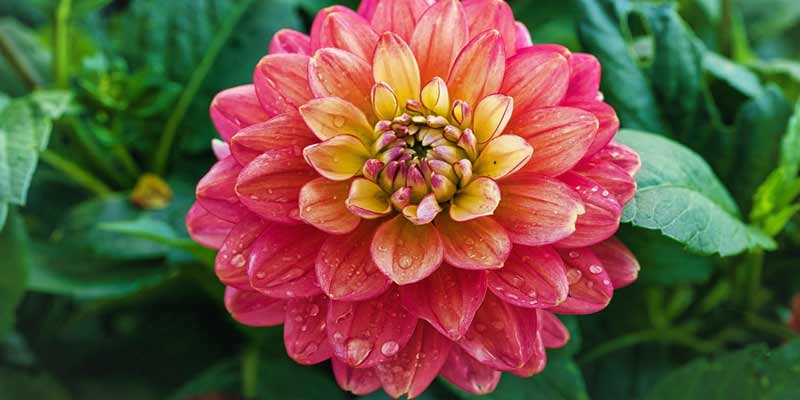With their captivating blooms and vibrant colors, dahlias delight gardeners. Native to Mexico, these stunning flowers have enchanted enthusiasts worldwide in gardens and landscapes alike with their beauty and versatility. To guarantee the thriving flourish of your dahlias, you must prioritize proper watering.
Determining the ideal frequency, however, remains a delicate balance: we must delve into the art of dahlia care. How often should one water these remarkable flowers for optimal growth and health?
Understanding Dahlia Watering Needs
Well-drained soil is preferred by dahlias, as they are known. They, like numerous plants, necessitate water for their flourishing; however, an excess of moisture can induce root rot and other complications.
Hence, maintaining a healthy dahlia plant throughout the growing season hinges on striking the perfect balance.
Soil Moisture and Drainage
To begin a discussion on watering frequency, one must first evaluate the moisture levels and drainage capacity of the soil as this is crucial. It’s worth noting that dahlia plants favor moist soil, yet not waterlogged; however, heavy clay soils present an issue.
These types of earthy compositions possess prolonged moisture retention capabilities which escalate the peril for root rot due to its propensity towards longer periods with sufficient wetness.
Conversely, sandy soils exhibit rapid drainage; thus, they necessitate more frequent watering. By amending the soil with organic matter, an action that enhances its structure and capacity for retaining water, one can effectively address this issue.
Environmental Factors
Significantly determining the watering frequency of your dahlias are environmental conditions: temperature, humidity, and sunlight exposure. These factors directly influence soil moisture evaporation rates; thus, it is during hot and particularly dry weather that more frequent watering may be necessary to prevent dehydration in dahlias.
Conversely, cooler temperatures and higher humidity levels may necessitate less frequent watering.
Establishment Phase vs. Established Plants
Depending on their growth stage, dahlias require varying amounts of water. To encourage root establishment and initial growth in newly planted dahlias, one must provide consistent moisture.
Throughout the establishment phase, it is crucial to monitor soil moisture closely; only water as necessary – ensuring that the root zone maintains a consistent level of moistness without becoming waterlogged.
Once dahlias are established, they become more resilient and drought-tolerant, requiring less frequent watering.
Watering Methods
The watering method can indeed affect the frequency of necessary dahlia hydration. Commonly, people employ overhead watering with a hose or sprinkler system; however, this practice intensifies foliage disease risk—especially when leaves persist in moisture for prolonged periods.
In contrast, drip irrigation and soaker hoses offer a solution—they directly deliver water to the root zone – thereby minimizing moisture on foliage and curtailing disease susceptibility.
Determining the Frequency
After we explore the factors that influence dahlia watering, we can now discuss the frequency at which you ought to water your dahlias:
Visual Inspection
To determine your dahlias’ water needs, utilize this straightforward method: visually inspect the soil. Conduct a moisture assessment by inserting your finger into the soil near the base; if you detect dryness below its surface at several inches of depth to be precise, then it is an unmistakable sign that watering time has arrived.
If the soil retains moisture, abstain from watering; overwatering may result in root suffocation and fungal diseases.
Watering Schedule
Maintaining consistent soil moisture levels and mitigating drought stress become achievable through the establishment of a regular watering schedule. Aim for deep yet infrequent watering of your dahlias, permitting slight dryness in the soil between each session.
Depending on environmental conditions, you might have to administer 1-3 weekly waterings during their growing season.
Always tailor your watering frequency to the needs of the soil moisture and plants, rather than rigidly adhering to a set schedule.
Mulching
You can conserve soil moisture and regulate temperature fluctuations in your dahlia plants by applying a layer of organic mulch, such as shredded bark or compost. Mulching suppresses weed growth; over time, it improves the structure of the soil.
However, be cautious not to make the mulch layer too thick: an excessive amount of mulch can impede water from reaching the soil and hinder air circulation around plant roots.
Rainfall Considerations
Consider the natural rainfall in determining your dahlia watering schedule; if regular rainfall occurs in your region, adjust accordingly.
Throughout heavy rain periods, vigilantly monitor soil moisture levels to avoid waterlogging and guarantee proper drainage.
Conclusion
Maintaining healthy and vibrant dahlias in your garden necessitates essential, proper watering. You can establish a robust growth-promoting and abundant bloom-inducing watering regimen by comprehending the unique needs of dahlias for water and monitoring environmental factors.
Prioritize soil moisture balance; adjust the frequency of watering based on plant requirements – utilize mulching techniques to conserve moisture and enhance soil health. Your meticulous attention to detail and care will coax your dahlias into thriving, rewarding you with their awe-inspiring beauty year after year.



Leave a Reply